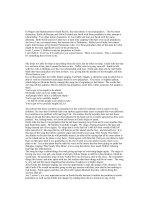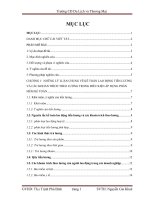Admiralty distance tables pacific ocean volume3
Bạn đang xem bản rút gọn của tài liệu. Xem và tải ngay bản đầy đủ của tài liệu tại đây (3.38 MB, 160 trang )
NP 350(3)
ADMIRAL TV DISTANCE TABLES
PACIFIC OCEAN
covering
Pacific Ocean and Seas bordering it
FIRST EDITION
1984
Published by The Hydrographer
of the Navy
©
Crown Copyright 1984
To be obtained from the Agents for the sale of Admiralty
PREVIOUS EDITIONS:
Admiralty
Distance Tables, Volume V
1st Edition 1919
2nd Edition 1953
Charts.
PREFACE
This first edition of Admiralty Distance Tables-Pacific Ocean has been prepared by Lieutenant Commander C. J. de
C. Scott, RN, and contains distance tables for the Pacific Ocean and Seas bordering it. The tables have been compiled
from the latest information in the Hydrographic Department, the distances have been completely re-worked, the
areas re-arranged and the information presented in a different format from Admiralty Distance Tables Volume V 2nd
Edition 1953, which it supersedes.
D. W. Haslam
Rear-Admiral
Hydrographer of the Navy
Hydrographic Department
Ministry of Defence
Taunton
Somerset TA1 2DN
20 September
1984
iii
iv
CONTENTS
Page
iii
iv
Preface
Contents
List of Diagrams
Introduction
v
vii
General Notes on Tables in this Volume
xxii
Table 1
South China Sea.
1
Table 2
Palawan Passage.
13
Table 3
Sulu and Celebes Seas.
17
Table 4
Eastern China Sea and Yellow Sea.
25
Table 5
Bo Hai.
29
Table 6
Seto Naikai.
31
Table 7
Sea of Japan.
35
Table 8
Sea of Okhotsk.
39
Table 9
Bering Sea.
43
Table 10
British Columbia.
45
Table 11
Australia-NE
Table 12
Pacific Ocean.
Table 13
Pacific Westbound
Coast-Inner
Route.
51
55
Routes.
99
Link Tables
113
Gazetteer
133
LIST OF DIAGRAMS
LIST OF DIAGRAMS
1.
2.
3.
4.
5.
Shape of the Earth
Meridional Parts
Mean and Middle Latitudes
Great circle track
Composite Sailing
Index Chart
Index Chart
Index Chart
Index Chart
Index Chart
Index Chart
Index Chart
Index Chart
Index Chart
1-Diagram of Index Charts
2-South China Sea and Palawan Passage
3-Sulu and Celebes Seas and Palawan Passage
4-Eastern China Sea and Yellow Sea and Bo Hai
5-Sea of Japan
6-Sea of Okhotsk
7 -Bering Sea and Seto Naikai
8-British
Columbia
9-Australia-NE
Coast-Inner
Route
Page
ix
xii
xiii
xiv
xix
Index
Chart section
following page 145
v
ADMIRAL TV DISTANCE TABLES
PACIFIC OCEAN
INTRODUCTION
1. Selecting a route. The routes used for distances in these tables, which are the shortest routes, are not
necessarily the quickest or most suitable for a particular passage: other routes may offer more favourable currents or
conditions of sea, swell or weather. The choice of the best route is described in Ocean Passages for the World and the
various volumes of Admiralty Sailing Directions: Routeing Charts show some of the principal commonly-used routes.
Essential to this choice, is a knowledge of the shortest distance between the point of departure and destination, which
can then be modified as circumstances require. It is these shortest navigable distances which are given in these
tables.
Since the Pacific Ocean is of such a size that great circle routes diverge appreciably from rhumb line routes, and the
straits between the many islands bordering its Nand W shores often offer alternative routes differing little in distance,
the shortest route between two places is not always immediately apparent. To help select appropriate connecting
points, near the great circle route between two stations, with which to enter the tables, Gnomonic Charts can
sometimes be consulted to advantage.
Where traffic separation schemes exist, they have not necessarily been followed.
2. Terminal positions. The geographical positions of the places tabulated, together with those of places
mentioned in the notes, will be found in the Gazetteer.
Most of the terminal positions are pilot grounds or anchorages given in Admiralty Sailing Directions, but some are
positions on the most commonly-used tracks in the entrances to large ports, rivers, or inlets containing a number of
ports. Consequently the named terminal position in the tables may be an appreciable distance from the place after
which it is named, or from the ship's actual berth.
3. Depths. Where routes are available for ships drawing 10m, they have been used for the distances in the tables.
Where there is not this depth, such as in harbour approaches or where there are off-lying shoals, the deepest
recommended channels have been used.
4.
Distances in the tables are given in International Nautical Miles. (See paragraph 7b.)
5. Notes on routes and distances. Each table is preceded by a list of notes applicable to certain distances in that
table. The small figures below the distance figures in the table refer to the notes.
vii
viii
6. To use the tables
Locate terminal positions in the tables nearest to the required departure and destination from the index chartlets.
(a)
Places in the same table. With the name of the place first in alphabetical order, enter the head of the
appropriate page of the table. Follow the column down until it meets the line corresponding to the other place named
at the side. At this intersection will be found the distance between the two places, with the reference to any notes in
small figures immediately below it.
(b)
Places in adjacent tables. Obtain the distance by adding the distances from departure or destination through
a place common to both tables.
Places in non-adjacent tables. Work the distance through places common to the intervening table or tables,
or if more than one table intervenes Link Tables (page 113) may be used.
(c)
Examples
Places in the same table
Vladivostok-Busan.
Index Chart 5 shows that both places lie within the area of Table 7.
Entering the head of Table 7 (page 37) at Busan (the name first in alphabetical order) follow the column to
Vladivostok to obtain the distance of 515 miles.
(a)
Places in adjacent tables
Vladivostok-Incheon.
Index Charts 4 and 5 show that Tables 4 and 7 can be used, connecting through KOREA STRAIT-W.
Entering the head of Table 7 (page 37) at KOREA STRAIT-W:
KOREASTRAIT-W-Vladivostok
Entering the head of Table 4 (page 28) at Incheon:
Incheon-KOREA STRAIT-W
(b)
Giving Vladivostok-Incheon
544
368
912
(c)
Places in non-adjacent tables
Vladivostok- Tarakan.
From the Index Charts it will be seen that a route, likely to be the shortest, will pass through Korea and San Bernadino
Straits. From the tables the component distances can be obtained thus:
Table
Vladivostok-KOREA STRAIT-E
7 (page
KOREA STRAIT-E-NANSEI
SHOTC-S
4 (page
NANSEI SHOTC-S-SAN
BERNADINO STRAIT 12 (page
SAN BERNADINO STRAIT- Tarakan
3 (page
Giving Vladivostok-
37)
28)
91)
23)
Distance
565
539
781}
Tarakan
An alternative route, passing W of Luzon, can be worked as follows:
713
2598
.
or 1320 from Link Table J (page 126)
x
(b) Length of a mile_ The Sea Mile is the length of one minute of arc measured along the meridian in the latitude
of a given place. It varies with latitude and the Figure of the Earth in use, and is shortest at the equator (1842'9m)
and longest at the poles (1861·7m).
For the International Spheroid the length of a sea mile in latitude l is given by the formula:
Sea Mile in latitude l=1852'27561-9'37069xcos
2l+0'01975xcos
4l-O·00004xcos
6l ... metres
But for practical purposes, the first two terms alone are adequate.
The International Nautical Mile is definer! as a distance of 1852m (6076'1 feet). Therefore the length of an arc of a
'd'
d'
. I
h
d .h
men lan, minutes In engt an Wit
nll
ddl
I . d l
(1852,27561-9,37069
e atltu e =
1852
= (1-000 1488-0-0050598
xcos 2l) xd IN'
nt.
xcos2L)
autlca
I M'I
I es
xd Int. Nautical Miles
This correction reaches its greatest value of about 0·5% at the equator and at the poles. When applied to the distance
between two places in different latitudes the value of the mean latitude may be used for l without appreciable error.
Example
A ship steams from rN
Nautical Miles.
to 5 S along a meridian, a distance of 720' of arc. To find the distance in International
0
Mean latitude = 1° N.
Arc distance = [1 ,000 1488-0·005 0598 x cos (2 x FO)] 720
= [1 ·000 1488-0·005 0598 x 0·999 3908] 720
= 716-5 Int. Nautical Miles
For most purposes in practical navigation, this adjustment for the International Nautical Mile can be disregarded, but
if necessary it can be readily applied to the formulae for the sphere used in the following sections.
8.
Rhumb line sailing
(a)
A rhumb line, or loxodrome, is a line on the earth's surface which cuts all meridians at a constant angle. It
therefore plots on a Mercator chart as a straight line.
Rhumb line distances taken from a Mercator chart are only acceptable if measured on the latitude or distance scale
of the chart within the band of latitude covering the distance in question, and when the difference of latitude is not
great. With small-scale charts and a large difference of latitude, considerable errors may occur unless great care is
taken in using the latitude scale, particularly in high latitudes.
The course and distance between two places may be calculated approximately by plane sailing formulae, or exactly
by meridional parts or middle latitude sailing formulae.
(ii i)
When angles are entered to obtain a trigonometrical function, most instruments will show the correct +ve or
-ve sign. If the -ve sign is not shown it should be entered, if necessary, as indicated in the table below.
When entering a trigonometrical function to obtain an angle, ambiguity may arise over the correct quadrant in which
the resulting angle should lie. First the correct quadrant must be determined by inspection, then the correct angle
must be obtained by addition or subtraction, if necessary, from 180° or 360°, as indicated by the arrows in the
following table.
00~90°
+
+
+
sin
cos
tan
900~180°
+
1800~270°
-
270°~360°
-
+
+
-
eg The angle whose sine is +0·5 may be 30° or 150° (ie 180°-30°), while the sine of -0·5 may be 210° (ie 180°+30°) or
330° (ie 360°-30°).
(a)
To calculate the great circle distance
The most convenient formula is the Haversine formula:
hav p=hav (f "'-'t) +sin f x sin tx hav L P
which is adapted for great circle work as:
hav FT=hav [(90 -Lat
F) "'-'(90 ±Lat T)]+sin
0
0
(90 -Lat
0
F)xsin
(90 ±Lat T)xhav d.long (FT)
0
Example
F is a position off Cadiz in 36 N, 7 Wand T is off Monte Video in 35 5, 56 W.
0
0
0
0
To find the great circle distance between them.
By tables
The Haversine formula gives:
d.long
PF
PT
PF "'-'PT
= 49
= 54
= 1 25
= 71
0
0
0
log hav 9·23545
log sin 9,90796
log sin 9·91336
0
9,05677 ---+
anti-log
hav PF "'-'PT
hav FT
0·11397
0·33722
. 0·45119
The angular distance FT therefore equals 84 23!9 or 5,063:9
0
xv
From formula (3)
Giving Dep AB
= 260-4
log d.long AB
log cas Lat L
2·64640
9,769 22
log
2-415 62
Summing the distances: FA
TB
AB
Total distance by composite track
2690·9
2381 ·6
260·4
= 5332-9 miles (minutes of arc on spherical earth)
By calculator
F
T
L
Lat
Lat
Lat
-35~0
-38~5
-54~0
Long
Long
20~0
141 ~5
From formula (1)
Giving
cas FA
=
FA
=
sin (-35~0)
sin (-54~0)
44~848 06 or FA = 2690-9'
From formula (2)
sin FA
sin L FPA
=
d.long FA
Long F
= 59~420 69
Long A
= 79~420 69 or 79 25.2' E
cas (-35~0)
Giving
Hence
20~000 00
0
From formula (1)
sin (-38~5)
cas TB
Giving
TB
=
=
sin (-54~0)
39~693 64 or TB
=
2381-6'
Route
SOUTH CHINA SEA
TABLE 1
SOUTH CHINA SEA-TABLE 1
1
SOUTH CHINA SEA-TABLE
1
Routes. A Dangerous Ground (Index Chart 2) lies in the S part of South China Sea. It is considered as being bounded on the N
and W sides by lines joining the following positions:
(a)
(b)
(e)
(d)
N
E
r20'
8°30'
11°40'
12°15'
109°00'
110°00'
114°10'
116°45'
It extends SE to Palawan Passage between the stations in the Table at the Nand S ends of the Passage, namely:
N
(a)
(b)
PALAWAN PASSAGE-N
PALAWAN PASSAGE-S
E
11°00'
4°00'
118°22'
112°32'
Distances in this Table across the South China Sea are by tracks round and not through the Dangerous Ground.
Notes
1 To seaward end of Air Musi: 8. To Palembang: 66.
2 To Bangkok: 38.
3 Distances are to La-sa-wei. From La-sa-wei to Guangzhou Harbour: 84. From places E of Hong Kong, except PALAWAN
PASSAGE-N,
the shortest route to Guangzhou Harbour is via Hong Kong, see Note 129.
4
To Haiphong harbour: 192.
5
See paragraph preceding these notes.
6 To Pending: 17. To Kuching: 25.
7 To Ho Chi Minh City: 48.
8 To Sibu by Batang Rajang main channel: 61.
9 Through Palawan Passage.
10 Through Palawan Passage. If E of Macclesfield Bank and W of Dangerous Ground, add 30.
11 Through Palawan Passage. If E of Macclesfield Bank and W of Dangerous Ground, add 53.
12 Through Palawan Passage. If W of Dangerous Ground, add 65.
13 Through Palawan Passage. If W of Dangerous Ground, add 91.
14 Either through Palawan Passage, or W of Dangerous Ground and E of Pulau Bunguran Besar.
15 Through Palawan Passage. If W of Dangerous Ground and E of Pulau Bunguran Besar, add 1.
16 Through Palawan Passage. If W of Dangerous Ground and E of Pulau Bunguran Besar, add 22.
17 Through Palawan Passage. If W of Dangerous Ground, between Pulau Bunguran Besar and Subi Group, and E of Twilight
Reef, add 6.
18 Through Palawan Passage. If W of Dangerous Ground, between Pulau Bunguran Besar and Subi Group, and E of Twili~lht
Reef, add 7.
SOUTH CHINA SEA-TABLE
1
3
19
20
21
22
23
24
25
26
27
28
29
30
31
32
33
34
35
36
37
38
39
40
41
42
43
44
45
46
47
48
49
50
51
52
53
54
55
Through Palawan Passage. If Waf Dangerous Ground, between Pulau Bunguran Besar and Subi Group, and E of Twilight
Reef, add 28.
Through Palawan Passage. If W of Dangerous Ground and E of Subi Group, add 2.
Through Palawan Passage. If W of Dangerous Ground and E of Subi Group, add 23.
Through Palawan Passage. If W of Dangerous Ground and E of Subi Group, add 44.
E of Twilight Reef, between Pulau Bunguran Besar and Subi Group, and Waf Dangerous Ground.
Waf Pulau Pejantan.
Waf Pulau Pejantan and Kepulauan Anambas.
E of Pulau Pejantan and W of Kepulauan Bodas.
N of Pulau Belitung.
N of Pulau Bangka.
S of Pulau Bangka.
E of Kepulauan Tujuh, and between Dao Phu Qui and Roche Yusun.
Through Philip Channel, Selat Durian and Selat Berhala. If through Selat Riau, and E of Kepulauan Lingga, add 7.
Through Selat Riau. If through Middle Channel (Singapore Strait). add 2.
Through Selat Riau. If through Middle Channel (Singapore Strait!, add 13.
Through Middle Channel (Singapore Strait).
Through Middle Channel (Singapore Strait) and between Dao Phu Qui and Roche Yusun.
Through Middle Channel (Singapore Strait), between Dao Phu Qui and Roche Yusun, and W of Paracel Islands: if between
Paracel Islands and Macclesfield Bank, add 31.
S of Pulau Ritan.
W of Pulau Midai.
S of Pulau Midai and through Serasan Passage.
N of Kepulauan Anambas and through Serasan Passage.
E of Kepulauan Anambas and W of Pulau Mendarik.
E of Kepulauan Anambas and W of Enslie Reef.
W of Kepulauan Anambas.
Between Pulau Bungurun Besar and Pulau Laut.
N of Pulau Laut.
W of Kepulauan Natuna Besar.
W of Kepulauan Natuna Besar and Dangerous Ground.
E of Subi Group.
E of Subi Group and W of Dangerous Ground.
N of Subi Group and S of Kepulauan Bodas.
S of Kepulauan Bodas.
Between Kepulauan Bodas and Karang Sedimin.
E of Pulau Redang.
W of Pulau Redang.
W of Pulau Redang and E of Ko Pha-ngan.









